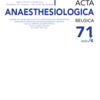A comparison of fetomaternal outcome in PCEA using fentanyl, clonidine and dexmedetomidine as adjuvants with Ropivacaine in painless labor: a prospective, double blinded randomized study
PCEA ; labor analgesia ; Fentanyl ; Clonidine ; Dexmedetomidine
Published online: Jun 30 2020
Abstract
Background: Patient controlled epidural analgesia has been associated with marked maternal satisfaction. Combination of local anesthetics with various adjuvants have been tried to ensure optimum analgesia with no or negligible fetomaternal side effects.
Aim: To compare fentanyl, clonidine or dexmedetomidine as adjuvants with ropivacaine for labor epidural analgesia (LEA) using a PCEA pump with the objective to assess fetomaternal outcome in terms of analgesic effect, success rate of vaginal delivery, complications, neonatal APGAR score and maternal satisfaction.
Materials and methods: Sixty full term laboring women received 10 ml 0.2% ropivacaine followed by continuous infusion of 0.1% ropivacaine with 2 μg/ml of either dexmedetomidine, fentanyl or clonidine respectively in Groups A, B, and C at 6 ml/hr. demand bolus setting was 2 ml with a lock out interval of 15 minutes. At full cervical dilatation another 10 ml bolus of respective solution were given. Parturients were monitored at 0, 10, 20, 30 min after giving 1st epidural bolus dose and then at 30 min interval for ongoing labor for pain relief (VAS), motor blockade (Bromage score), progress of labor (duration of 1st stage and 2nd stage), mode of delivery, fetal APGAR score (at 1 min and 5 min), vitals (HR, NIBP, RR, SpO2), overall patient satisfaction and complications. The statistical analysis was done both qualitatively (Fisher-exact test/Chi-square test) and quantitatively (one-way analysis of variance test with post-hoc intergroup comparisons using Bonferroni’s correction).
Results: Onset of pain relief was earlier in fentanyl group, however after 1 h all three groups showed comparable pain relief (P>0.05). There was a significant reduction in HR in group C and B compared to group A (P<0.001) and MAP in group C compared to groups A and B. The motor- blocking potency was slightly higher in dexmedetomidine group, however no significant motor weakness observed in any parturient. Mean demand bolus need was more in group C compared to A and B (P<0.001). There was no significant difference in mode of delivery (either SVD or cesarean) in between the groups. There was not a single case of fetal distress and most of the parturients showed satisfactory response to PCEA.
Conclusion: All three study drugs produced equipotent analgesia in combination with ropivacaine 0.1%. There was absolute pain relief without significant motor blockade or any increase in instrumentation/cesarean deliveries or any adverse fetal outcomes.
